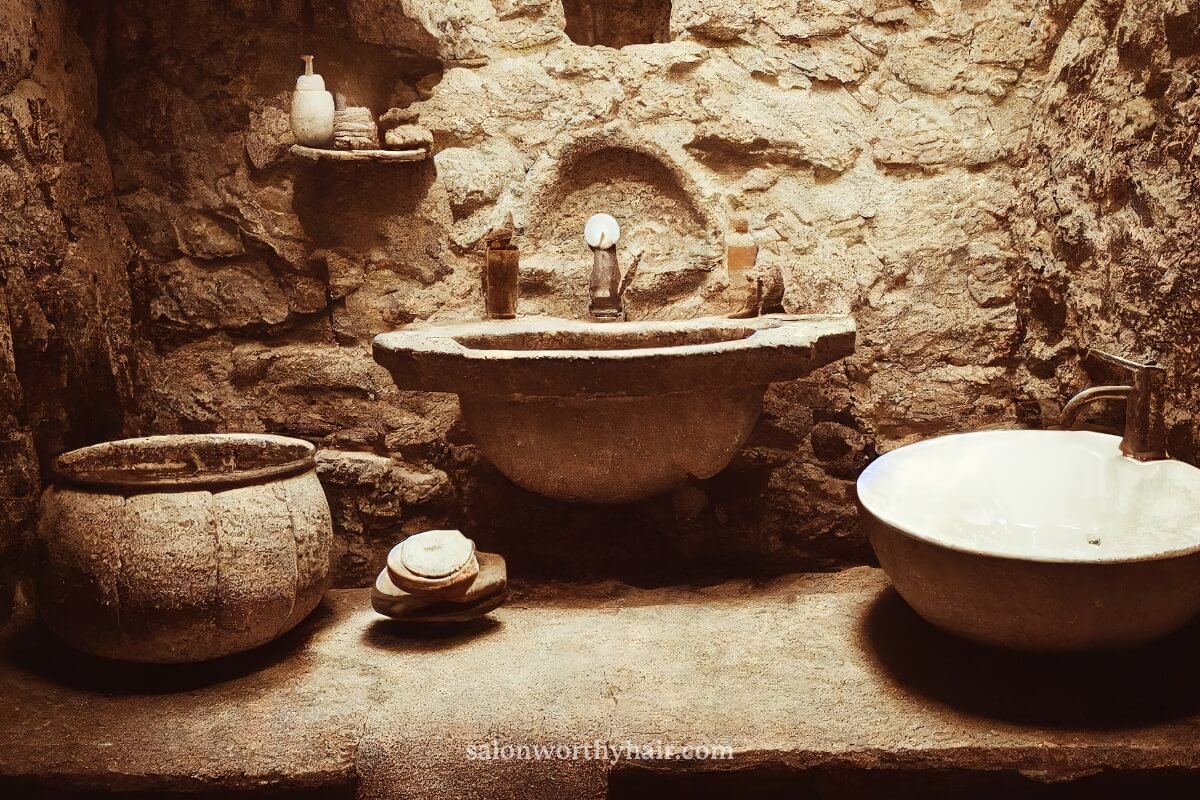Oil Cleansing Method – Does Washing Hair With Oil Work?
Updated on
This post may contain affiliate links. As an Amazon Associate, we may earn from qualifying purchases.

I know this may sound weird, but washing hair with oil is now a thing!
Contrary to the common belief that shampoos (including dry shampoos) are the best way to clean hair, many individuals have discovered that these products can sometimes leave their hair dry, frizzy, and more susceptible to breakage. As a result, more people are turning to oil-based hair cleansing for a gentler approach to hair care.
Curious about how this technique works?
Read on as we delve into the science of oil cleansing to explain how and why it works for the hair and scalp.
Table of Contents
- Before Soap Was Invented People Used Oil and Ash to Cleanse
- How Does the Oil Cleansing Method Work?
- Washing Hair With Oil – A Gentler Alternative to Shampoos
- Benefits of Emulsifying Oil Cleansers for Hair
- Best Hair Cleansing Oils
- Best Scalp Cleansing Oils
- How to Wash Hair and Scalp With Oil – Step By Step
- Emulsifying Oil Vs. Regular Oil or Cooking Oil for Hair
- Can Traditional Hair Oiling Cleanse the Hair and Scalp?
- tl;dr;
Before Soap Was Invented People Used Oil and Ash to Cleanse

The Oil Cleansing Method (OCM) has its roots in ancient bathing practices that existed before the invention of soap. These practices involved using oils, such as olive oil, sometimes mixed with ash, to cleanse the body by rubbing them onto the skin.
The concept is based on the idea that oil can dissolve dirt and impurities from the skin, which can then be rinsed off with water.
Oil washing for hair follows a similar principle. Instead of using commercial shampoos, oil is used to cleanse the hair.
However, I must emphasize that not any oil will work; choosing the right type of oil is critical for achieving the desired results. Further details on this specific oil formulation is discussed below. 👇
How Does the Oil Cleansing Method Work?
The principle behind oil cleansing is based on the concept that “like dissolves like,” meaning that oil can dissolve other oils and substances with similar properties.
Oil can effectively break down and dissolve oil-based substances such as sebum, makeup, and hair styling product buildup. When used to cleanse the skin, scalp, and hair, it interacts with oil-based impurities, making them easier to remove.
Another way to explain how oil works as a cleanser is to examine soaps and shampoos.
Soaps and Shampoos Use Oils As Their Base
Here’s a quick chemistry lesson from SciShow kids:

As you can see, oils and fatty acids are often included as base ingredients in many shampoos and soaps. They contribute to the cleansing process by using their lipophilic (oil-loving) properties to attract grime.
The heavy lifting is performed by surfactants, which are molecules with both lipophilic (oil-loving) and hydrophilic (water-loving) properties.
The lipophilic part of the surfactant molecule is attracted to and dissolves dirt and grease, while the hydrophilic part is attracted to water. When the soap or shampoo is rinsed off, the surfactants form micelles, with the lipophilic parts trapping the dirt and the hydrophilic parts facing the water.
This process, known as emulsification, allows dirt, scalp flakes, excess oils, and product buildup to be suspended in water and washed away effectively. [1]
I’m sure you’ve been told time and time again that oil is a cardinal sin for your skin. It can clog the pores and cause breakouts.
But modern research is proving those assumptions wrong.
Read: Why Dermatologists want you to consider the oil-cleansing method.Here’s the thing …
You probably use a makeup remover every night. Right?
Everyone loves that fresh feeling of removing layers of makeup in just one swipe. Because it just works and feels so satisfying at the end of a long day.
But did you know?
Makeup removers, particularly oil-based ones, can be considered an oil cleansers. They typically contain oils and emulsifiers that help to dissolve makeup, dirt, and excess oil on the skin.
So here’s the basic science behind how most makeup removers work:
They use oil to absorb oil.
Also known as the Hydrophobic Effect, oil absorbs and dissolves sebum, grease, and makeup without stripping the skin’s natural acidic barrier (the acid mantle).
Cleansing oils contain hydrating and soothing ingredients that may be more effective and less irritating than traditional cleansers.
“Cleansing oils contain hydrating and soothing ingredients that may actually be more effective and less irritating than some traditional cleansers.Contrary to what you may think, cleansing oils won’t leave your skin greasy or heavy. Oil absorbs oil, which means that these products can effectively remove dirt from and leave the skin clean.”
– says Joshua Zeichner, M.D., New York City–based certified Dermatologist.
With more research coming out each year to highlight the dangers of sulfate-based shampoos, isn’t it the right time you try something different for your hair too?
Washing Hair With Oil – A Gentler Alternative to Shampoos

Washing hair with oil is an alternative hair care method in which oil is used as the primary cleansing agent instead of traditional shampoos. But there is more to it than just grabbing a bottle of oil from your kitchen and pouring it on your head.
You must choose the right oil and understand the process to prevent potential issues such as greasy hair or an unbalanced scalp. The proper oil selection typically involves using a specially formulated oil or oil blend containing emulsifying agents, which help the oil to mix with water and effectively cleanse the hair and scalp.
The oil cleansing method for hair generally involves:
- Massaging the chosen oil into the scalp and hair.
- Allowing it to break down and dissolve dirt.
- Removing excess sebum.
- Removing dirt and product buildup.
After the oil has been applied and left to work, it is rinsed out to ensure complete removal.
To effectively wash your hair with oil, you must adopt the same principle of makeup removers – that is to use an emulsifying oil.
What Is an Emulsifying Oil?
An emulsifier is a substance that facilitates the mixing of immiscible liquids, such as oil and water, by reducing surface tension between them. Commonly used in oil cleansers, emulsifiers have hydrophilic (water-loving) and lipophilic (oil-loving) properties, allowing them to dissolve in water and oil. The presence of an emulsifier in an oil-based cleanser enhances its efficacy and rinsability by forming micelles that encapsulate oil and impurities, making them easy to rinse away with water.
Emulsifiers, often surfactants, are crucial in formulating stable and effective oil cleansers for skincare and haircare purposes.
An emulsifying oil will often become a milky and runny type of liquid when it comes into contact with water. This transformation occurs due to emulsifying agents within the oil, which enable the oil to mix with water effectively. The resulting milky consistency helps to break down and dissolve dirt, excess sebum, and grime from the hair and scalp, allowing for easy rinsing and removal during the cleansing process. This characteristic is particularly beneficial for oil-based hair cleansing methods, as it ensures thorough cleaning without leaving behind a greasy layer on the hair.
Benefits of Emulsifying Oil Cleansers for Hair
Emulsifying hair cleansing oils can offer several benefits for hair care as they combine the nourishing properties of natual oils with the ability to mix with water for easy rinsing.
Here are the benefits:
- Effective cleansing:Emulsifying oil cleansers can remove dirt, sebum, and product buildup from the hair and scalp by dissolving and encapsulating them in micelles for easy rinsing.
- Moisturizing and nourishing:The oils in emulsifying cleansers provide essential nutrients, vitamins, and fatty acids that can help moisturize, nourish, and strengthen hair strands, improving hair health and manageability.
- Gentle on hair and scalp:These products are typically more gentle than harsh sulfate-based shampoos, which can strip the hair and scalp of their natural oils, leading to dryness and irritation.
- Improved manageability:They can help reduce frizz, tangles, and static by conditioning and smoothing the hair cuticle, making it easier to comb and style.
- Versatility:They can be suitable for various hair types, including dry, damaged, or color-treated hair, as they can be formulated with different oils and emulsifiers to address specific hair concerns.
- Reduced scalp issues:By effectively cleansing the scalp without causing dryness or irritation, oil cleansing can improve the scalp’s natural oil production and help alleviate problems such as scalp acne, flaky scalp, dandruff, itchiness, and inflammation.
- Pre-shampoo treatment alternative:They can serve as pre-shampoo oil treatments, offering the benefits of oil-based nourishment while being easy to rinse during the cleansing process.
Overall, emulsifying oil cleansers for hair can provide effective cleansing, nourishment, and gentle care for various hair types and concerns, making them a valuable addition to any hair care routine.
If you want to give this method a try, we’ve selected a few products that are excellent for both the hair and scalp below:
Best Hair Cleansing Oils
DHC Deep Cleansing Oil
After trying many different oils, including cooking oils, I landed on this DHC product.
I’ve tried coconut oil, olive oil, foaming shampoos with oil, and more products than you could shake a stick at. None even come close to the effectiveness of the DHC Deep Cleansing Oil.
The reason why I love it is simple, it works.
Here’s why it’s so effective:
- Emulsifying Agent:It has active emulsifying agents, allowing it to wash out as easily as shampoo, leaving little to no oily residue.
- Rich in Vitamin E & Antioxidants:Secondly, it’s rich in vitamin E and antioxidants, which shampoos aren’t, giving your hair all the love it needs to stay strong and healthy.
- It removes dirt and grime:It’s specifically designed to melt away dirt, grime, and pollutants without clogging the pores on the skin.
My only gripe is the price tag. It isn’t cheap.
Shu Uemura Moisture Balancing Cleansing Oil Shampoo
If you want the benefits of using oil but are not ready to give up your shampoo, try the Shu Uemura cleansing oil shampoo hybrid. Although it does contain sodium laureth sulfate, which I would advise against using, it has armeniaca kernel oil, apricot kernel oil, olea europaea oil, olive oil, oryza sativa bran oil, and rice bran oil, which offset the surfactants to leave the hair nourished and moisturized.
Best Scalp Cleansing Oils
Amika Reset Pink Charcoal Scalp Cleansing Oil
Amika Reset Pink Charcoal Scalp Cleansing Oil is an oil-to-foam hybrid with pink charcoal to deeply cleanse and purify the scalp. It gently exfoliates, detoxifies, and oxygenates the scalp while also nourishing and hydrating the hair.
L'Occitane Cleansing And Softening Almond Shower Oil
L’Occitane Cleansing and Softening Almond Shower Oil is enriched with almond oil, known for its nourishing and hydrating properties. The shower oil also contains a blend of natural ingredients, including grape seed oil and sunflower seed oil, which work together to cleanse and soften the skin and provide essential nutrients to the scalp and hair.
It is suitable for all skin and hair types. If you suffer from sensitive scalp, this product can help.
It is sulfate-free, paraben-free, and silicone-free, making it a great option for people looking for a natural and gentle cleansing option.
And yes, it contains emulsifiers, which help to create a rich and luxurious lather, making it a pleasure to use.
How to Wash Hair and Scalp With Oil – Step By Step
Now that you know which oils to use to wash your hair, here are the step-by-step instructions on how to do it:
Before you start, read the following caution tips:
If you have oily or acne-prone skin, be cautious when applying the cleansing oil near your hairline and face, as it may contribute to breakouts. Consider using a separate facial cleanser to remove any oil residue on your skin.
- Detangle:Before applying the cleansing oil, gently detangle your hair using a wide-tooth comb or a brush with flexible bristles. This will make it easier to distribute the oil evenly throughout your hair and prevent breakage during washing.
- Wet hair:Thoroughly wet your hair with warm water to open the hair cuticles and prepare your scalp for cleansing. Warm water can also help the oil emulsify more effectively.
- Apply oil:Pour a small amount of cleansing oil into your palm (adjust the amount based on your hair length and thickness). Rub your hands together to distribute the oil evenly, and then apply it to your scalp and hair, focusing on areas with buildup or dryness.
- Massage:Gently massage the cleansing oil into your scalp using a circular motion with your fingertips. This will help to dislodge dirt, sebum, and product buildup. Work the oil down the length of your hair, ensuring it is evenly distributed.
- Add water:After massaging the oil into your hair and scalp, add a small amount of water to your hands and work it into your hair. This will help the cleansing oil emulsify and create a light lather. Continue massaging your scalp and hair to further distribute the emulsified oil.
- Rinse:Thoroughly rinse your hair and scalp with warm water, removing all the cleansing oil and any residue. It is important to rinse completely, as any remaining oil can weigh down your hair or make it look greasy.
- Follow up with conditioner (optional):Depending on your hair type and the cleansing oil used, you may want to follow up with a conditioner to further nourish and detangle your hair. Apply the conditioner to the mid-lengths and ends of your hair, avoiding the scalp, and let it sit for a few minutes before rinsing it.
- Dry and style:Gently squeeze out excess water from your hair and wrap it in a microfiber towel or an old t-shirt to absorb moisture and let your hair air dry (do not blow dry). Avoid rubbing your hair, as this can cause frizz and breakage. Once your hair is damp, proceed with your usual styling routine.
So there you have it.
If your hair feels heavy or greasy after using an emulsifying cleansing oil, you may need to experiment with different products or follow up with a gentle shampoo. You may also use a natural dry shampoo to help you during that transition period.
Emulsifying Oil Vs. Regular Oil or Cooking Oil for Hair
There is a big difference between regular, cooking, and emulsifying oils.
Emulsifying cleansing oils are formulated to wash out easily with pure water. On the other hand, cooking oils, coconut oil, jojoba oil, and other raw oil need shampoo to wash out.
The easiest way to tell the difference between an emulsifying cleansing oil and a regular oil is by checking the texture and consistency.
If it feels like a lotion or soap in your hand, you’re probably holding an emulsifying oil. Emulsifying oils are usually clear or slightly yellowish and have a light consistency that spreads easily across the skin. They are also formulated to cleanse without leaving residue on your skin. Regular oils will feel oily on your hand and may have a thicker consistency than emulsifying cleansing oils.
Can Traditional Hair Oiling Cleanse the Hair and Scalp?
It’s important not to confuse traditional hair oiling practices with the oil cleansing method.
Traditional hair oiling can provide several benefits for the hair and scalp, such as nourishment, hydration, and improved hair strength. However, it is not an effective method for cleansing the hair and scalp.
Treatments with amla oil, argan oil, castor oil, coconut oil, and essential oils, for example, can help to moisturize, reduce frizz, prevent protein loss, prevent hair loss, and stimulate growth, but they cannot remove dirt, sweat, and excess sebum the way shampoos do. A styling oil is also not a cleansing oil.
That said, applying oil to the hair before washing can help protect it from shampoo’s drying effects, particularly if you have dry or damaged hair.
Oil-based hair cleansers are formulated with emulsifiers and surfactants to create a product that effectively cleanses the hair and scalp while providing the benefits of traditional hair oiling.
tl;dr;
Washing hair with oil may seem like an obscure thing to do, but it works.
To do it effectively, you must use an emulsifying oil, not any regular oil.
You’ve got to give it a try to see the difference!
It may be the solution to all your hair woes.
References & Citations
- Hair cosmetics – An overview
How shampoo uses emulsification to remove dirt and buildup.
Retrieved on March 20, 2023.
https://www.ncbi.nlm.nih.gov/pmc/articles/PMC4387693/
About the Author
 Tina Moretti
Tina MorettiTina Moretti, a passionate hair care enthusiast with over a decade of expertise, dedicates herself to empowering women with proven hair care advice. Recognized for her hands-on experience and trusted guidance, Tina turns every strand into a statement of beauty and confidence.



